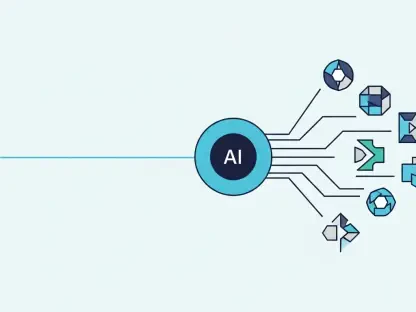Unveiling a Historic Shift in Government Technology
Imagine a landscape where the vast machinery of the US federal government operates with unprecedented efficiency, powered by cutting-edge artificial intelligence at a cost of mere pennies per agency. This scenario is no longer a distant vision but a reality with Google’s “Gemini for Government” deal, priced at an astonishing $0.47 per agency. Orchestrated by the General Services Administration (GSA) through the OneGov agreement extending to 2026, this contract marks a seismic shift in how technology integrates into public sector operations. This market analysis explores the implications of this historic partnership, dissecting its influence on government tech adoption, competitive dynamics, and long-term sustainability. The focus is on understanding how such an aggressive pricing strategy and comprehensive AI suite could redefine market trends and shape the future of federal governance in the digital era.
Dissecting Market Trends and Competitive Forces
The Rise of AI in Public Sector Contracts
The adoption of artificial intelligence within government operations has gained significant momentum over recent years, reflecting a broader trend of digital transformation across public sectors. Federal agencies have increasingly turned to advanced technologies like cloud computing and data analytics to enhance operational efficiency, setting the stage for more complex solutions like AI. Google’s latest deal builds on its established presence in the government space, where it already provides discounted tools to agencies, now expanding into a full-fledged AI ecosystem. This move aligns with national policy priorities emphasizing cost-effective commercial tech solutions, positioning AI as a cornerstone of modern governance and driving demand for scalable, secure platforms in the public sector market.
Unpacking the $0.47 Pricing Model
A standout feature of this agreement is its pricing structure, offering enterprise-level AI services at just $0.47 per agency, a figure that undercuts typical market rates by a wide margin. This aggressive strategy raises questions about its role in market positioning, with industry analysts suggesting it may be a loss-leader approach to secure dominance in the government tech space. Compared to competitors like Microsoft and Amazon, whose offerings often come with higher but more predictable costs, Google’s pricing could disrupt market equilibrium, potentially pressuring rivals to lower their rates. The long-term viability of such a model remains under scrutiny, as future price adjustments post-2026 could alter budget forecasts for federal agencies and reshape vendor-client relationships.
Security Standards as a Market Differentiator
Security remains a critical factor in the government tech market, where stringent standards dictate vendor selection. Google’s platform, equipped with FedRAMP High authorization and advanced protective features, meets these rigorous demands, providing a competitive edge in a sector where data integrity is non-negotiable. However, the expansive integration of AI tools across diverse agency operations introduces complexities in maintaining compliance and managing risks at scale. This balance between innovation and security will likely influence market perceptions, as vendors who can demonstrate robust safeguards alongside cutting-edge technology stand to gain significant traction among federal buyers.
Projecting Future Impacts on Government Tech Ecosystems
Innovation Benchmarks and Market Evolution
Looking ahead, the “Gemini for Government” suite, with tools like custom AI agents and enterprise search capabilities, is poised to set new benchmarks for innovation in government tech contracts. These advancements could accelerate the adoption of AI-driven automation, transforming mundane tasks into streamlined processes and freeing resources for strategic priorities. As other tech giants observe this trend, the market may see an influx of similar low-cost, high-value offerings, intensifying competition and driving rapid evolution in the types of solutions available to federal agencies. This shift could redefine expectations for technology procurement, emphasizing scalability and adaptability as key criteria.
Regulatory and Economic Ripples
The economic implications of this deal extend beyond immediate cost savings, potentially reshaping the competitive landscape of government tech markets. If Google’s pricing strategy succeeds in locking in long-term contracts, it might create barriers for smaller vendors or emerging players, raising concerns about market fairness and vendor dependency. Regulatory responses, such as updates to federal procurement policies between 2025 and 2027, could address these issues by encouraging diversity in vendor selection and mitigating risks of over-reliance on a single provider. Such changes would likely influence how future AI contracts are structured, balancing innovation with equitable market access.
Sustainability Challenges in Long-Term Adoption
Sustainability remains a pivotal concern as the government tech market adapts to widespread AI integration. While the current pricing appears advantageous, the lack of clear success metrics or implementation timelines in the agreement poses challenges for assessing its true value over time. Agencies with varying levels of technological readiness may struggle to fully leverage these tools, potentially leading to uneven adoption rates across the federal landscape. Market projections suggest that without strategic planning and investment in training, the transformative potential of this deal could be undermined, affecting both vendor credibility and government efficiency in the long run.
Reflecting on Market Shifts and Strategic Pathways
In retrospect, the analysis of Google’s $0.47 AI deal with the US federal government reveals a pivotal moment in the government technology market, blending unprecedented opportunity with notable risks. The partnership showcases the potential to redefine operational efficiency through advanced AI tools, yet it also highlights challenges like pricing sustainability and security at scale. For stakeholders, the path forward involves prioritizing robust training programs to ensure effective tool adoption across agencies. Additionally, advocating for procurement policies that foster competition helps mitigate dependency risks. By focusing on these actionable steps, the market can adapt to balance innovation with resilience, ensuring that such a historic deal paves the way for sustainable advancements in federal tech ecosystems.









